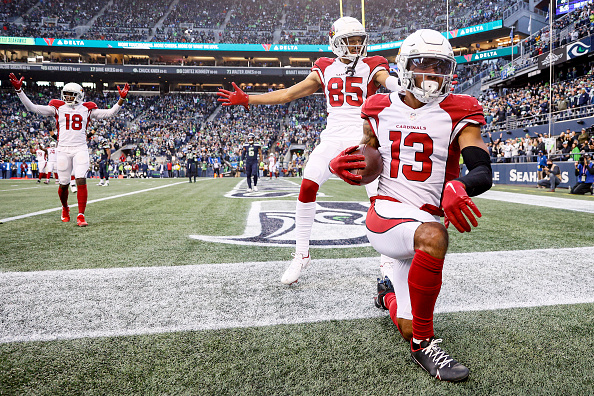The Arizona Cardinals are going to look significantly different next season. The team not only has a tonne of free agents, but also is contending with a significant number of cap increases to notable players. Some key Cardinals decisions are looming in the next few months. At wide receiver and tight end, though, these decisions are inextricably related. The futures of a handful of key players will ultimately define the direction of Arizona’s offensive weaponry in 2022.
Cardinals Decisions At Tight End And Wide Receiver Will Define One Another
Christian Kirk and The Slot
Christian Kirk has come to the end of his rookie deal. In 2021, Kirk impressed, reaching the cusp of a 1,000-yard season for the first time. Statistically, he was the team’s best receiver in the absence of DeAndre Hopkins; he led the team in both yards and receptions. After a somewhat inconsistent time spent in Arizona, he has found his role within this offense. He excelled in the slot, and, perhaps most importantly, has arguably the best relationship with quarterback Kyler Murray.
This off-season, bringing Kirk back makes a lot of sense schematically. However, with a projected market value of around $11 million/year, Kirk might have priced his way out of Arizona. Kirk’s value is certainly reflective of his ability, but Arizona may be hesitant to tie so much money up in one position; Hopkins will carry a cap hit of over $25 million next season, and Arizona still need a number two receiver.
Ultimately, Kirk’s proficiency in the slot means that his value in the open market far outweighs his value to a Cardinals team that needs to invest that wide receiver budget in an outside guy, not in the slot. Add in the fact that the Cardinals brought in a prototypical slot guy last year in Rondale Moore, who looks to be a more versatile and, more importantly, cheaper option in the slot, and the argument to bring back Kirk falters. Allowing Arizona’s best local product to walk is not ideal, but if he performs his way out of the desert, then so be it. Good for him.
Where Do The Tight Ends Come In?
Realty stalking aside, there is no indication of what the team intends to do with Kirk. However, if Kirk was retained, it would have significant ramifications on Arizona’s offense next season. Namely, Kliff Kingsbury would be almost obligated, with the amount of money tied up in receiver, to run a bunch of spread and 11-personnel formations. This would not be that notable of a shift; 11-personnel (3-WR, 1-TE, 1-RB) is Kingsbury’s most frequent formation, used on 55% of offensive plays in 2021.
However, to occupy that much money in receiver, and effectively define your offensive scheme, would be a disservice to the potential pairing that the Cardinals have at tight end. Kingsbury’s second-most frequent (21%) personnel grouping is 12-personnel (2-WR, 2-TE, 1-RB). Zach Ertz and Maxx Williams are the perfect complementary duo to thrive in an expansion of this system. Granted, the two have never played together, with Ertz coming over to replace Williams after injury this season. Yet, their skillsets project to offer a versatility out of this formation that Kingsbury can exploit. Ertz is a pure pass-catching guy, and Williams revealed a two-way ability in 2021. Between the two, Arizona would have a prototypical lineup to deploy in 12-personnel.
The two are set for free agency. Ertz, in particular, projects to be fairly expensive, carrying a similar annual value to Kirk. However, Ertz’s value to the team, as demonstrated down the stretch in 2021, is almost priceless. Many perceive Ertz as Arizona’s chief priority in free agency. Loading up at tight end offers Arizona more schematic versatility, especially if the team brings back Williams. Conveniently, his market value stands at around half of the likes of Ertz and Kirk.
Cardinals Decisions Will Necessitate A Marquee Outside Receiver
Schematically, the Cardinals can benefit from replacing Kirk with the cheaper option in Moore and bringing back both of their tight ends. However, this further necessitates acquiring a true number two wide receiver. Bringing back both tight ends would signal a clear intention to utilize more 12-personnel, and to bring back both and retain Kirk would be almost impossible, especially since Kirk has shown he’s better playing on the inside anyway; in a 12-personnel system, Kirk’s schematic value does not remotely match his price tag. Moore is not going to be playing on the outside either, but with a cap hit of $1.5 million, Arizona can feel better about leaving him on the sideline.
Allowing Kirk to leave, reassigning some of that money to bringing back both tight ends, then enhancing Arizona’s schematic versatility by picking up a receiver who can thrive in both 11 and 12-personnel, is a path Arizona should consider taking. There are some notable names in free agency, pricey, granted, but players who would offer Arizona more for their money than what they’d get from paying Kirk. Supposed want-away Atlanta Falcons receiver Calvin Ridley is one to monitor. He is under contract with the Falcons, but at $11 million/year value, the same as that which Arizona would have to pay Kirk, trading for Ridley would be a viable option.
The Cardinals decisions at wide receiver and tight end are an intriguing factor in what is set to be a busy off-season in Arizona. Kingsbury’s offensive direction should ultimately define which path the Cardinals choose to take with these intrinsically linked position groups. Yet, money is predictably the name of the game. Arizona have a considerable task constructing the best version of their roster for 2022.
Main Image:






